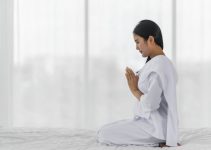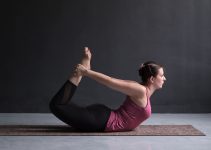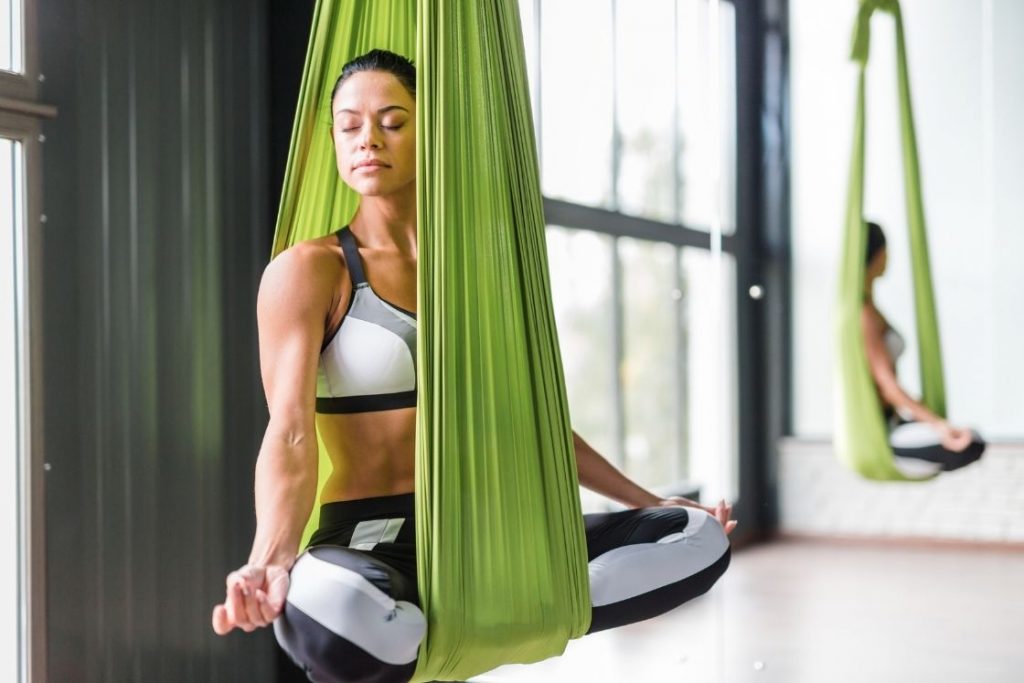
Anti-gravity yoga, upside-down yoga, flying yoga, air yoga, are all names of one of the fun and unique yoga style Aerial Yoga. It is practised using a hammock or a swing, which is suspended from the ceiling.
Though using props in yoga practice was already introduced by BKS Iyenger in the late 1900s, known as Iyenger Yoga, aerial yoga was created and popularized by gymnast Christopher Harrison.
With the help of gravity, you are working your muscles and joints in a way that would not have been possible in ground yoga poses. Apart from strengthening, you can also gain flexibility in your body and fluidity in aerial yoga poses.
Most poses practised in aerial yoga may be similar to the general yoga poses however, there are modifications done to support the pose on a fabric hanging from the ceiling. Challenging poses like headstands or planks can be easily performed as hanging from the swing can help you support the shoulder fabric.
Things beginners should know before joining aerial yoga class
For beginners, joining an aerial yoga class may be intimidating but there is no need for it. Go to the class with the expectations of having fun. Even if you do not have prior yoga experience, it is not a big deal, however, your body may take some time to come to terms with this style, which is completely fine.
Before joining any class, here few things that you should keep in mind:
1. Avoid the class in case of medical issues
If you have high blood pressure, dizziness, ear problems, or are pregnant, you should definitely not participate in an aerial yoga class unless approved by your doctor. People with recent surgeries or head injuries, who are prone to fainting spells or have brittle bones should avoid it altogether.
2. Form-fitting yet comfortable clothes
In most yoga or meditation classes, you are asked not to wear restrictive clothes as they may hamper your concentration.
In aerial yoga, you should wear fitted clothing so that the movement is in the swing is not difficult. It is advisable to wear a long-sleeved shirt and lowers, which can cover your armpits and back of the knees, and prevent chaffing.
3. Remove any accessory
Wearing jewelry is a big no-no. There are high chances that the fabric may get tangled or torn by the rings, necklace, or bracelet you are wearing. Having accessories on the clothes can also damage the fabric of the swing. Accessories such as hairpins, buckles should be completely avoided for an aerial yoga class.
4. No lotion, perfumes, or essential oils
Many people are using the hammocks/swings in aerial yoga classes. The strong perfume smell or greasiness of the lotion may cling to the fabric, hence it is always advised to avoid the use of perfume and/or lotion before an aerial yoga class. Also, using lotion can also result in loss of grip, which may be harmful to you.
5. Light or no meals before class
You should practice aerial yoga class after 2 hours of having a meal or if you are really hungry, have a light snack like fruits to avoid getting stomach cramps. Avoid drinking aerated drinks such as soft drinks or alcohol before the class.
A full stomach can result in vomiting, gassiness, or an overall upset stomach in hanging aerial yoga poses. You should, however, be properly hydrated as aerial yoga requires strength and is a high-intensity workout.
6. Be aware of the studio policies
Before joining any class, always check with studio policy about safety precautions, photographing, using your own water bottles or yoga mats, etc.
This way, you will be better mentally prepared for practising the poses. Here you can also have a good look at the instructors’ experience regarding this style of yoga.
Hammocks vs. Swings
Aerial yoga poses are mainly performed on hammocks and swings.
The major difference between them is that a hammock is a long piece of fabric that is hung from the ceilings like a sling. A swing has padded grips, adjustment straps, and handles to provide a wider range of support. Most aerial yoga classes will use either one of them or a combination of both.
Is it safe to practice aerial yoga at home?
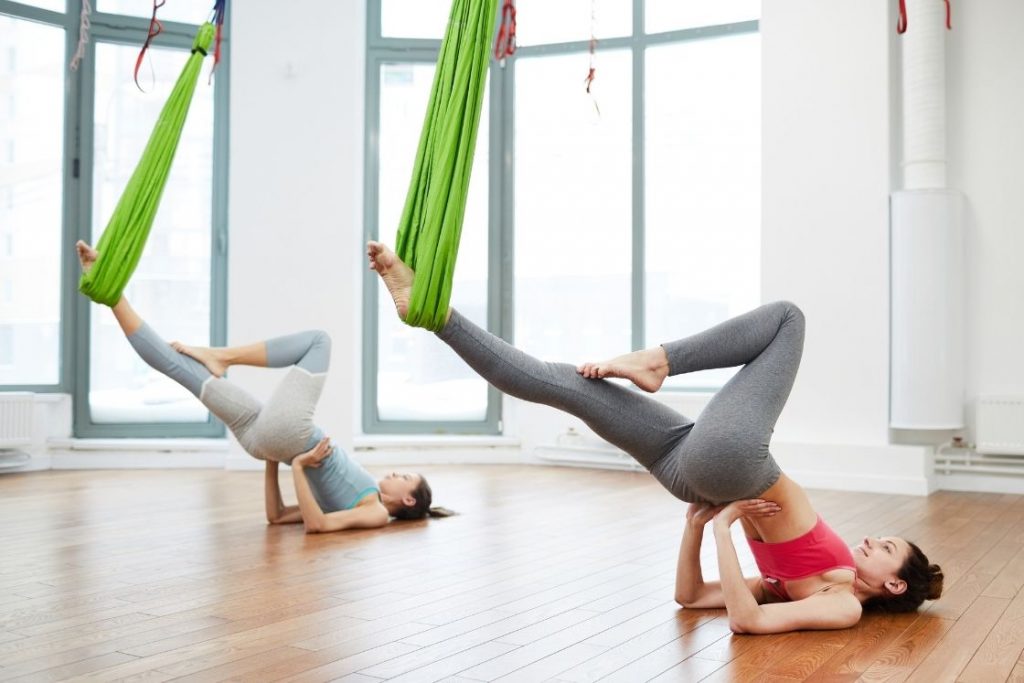
While there is no denying the fact that it is safe to practice aerial yoga at home as the instruments of aerial yoga are easily available, your first few classes should always be in a professional environment.
Begin with attending aerial yoga classes so that you can get a hang of all the poses you want to practice. In a class, the instructor will be constantly there to correct your poses or spot you which will help you in gaining the confidence to practice at home.
All you will need is the correct settings, hammock or swing, and a spotter at home to start your home workout. And you do not have to worry about being too high as for most of the poses you will be only 3 inches or 7.6 cm above the ground. If you want to be extra cautious, you can place a fluffy blanket beneath the swing.
Setting up aerial yoga swing at home
Now that we have established that you can practice aerial yoga at home, it is time to tell you the tips for building a yoga swing at home.
The most important factor in aerial yoga is the swing from which you hang yourself in a pose. The quality of the fabric, the price, the options of handles and the weight it can support. Generally, a swing can support a weight of up to 300 pounds or 140 kg, but there are swings that can withstand more. The fabric should be made of high quality nylon that will not tear even if stretched slightly.
Secondly, the installation of the swing also plays a big role. An aerial yoga swing needs enough space and it is recommended that there should be at least three meters of height and two meters of horizontal space to move freely while hanging.
If you are an expert in rigging, go right ahead with installing the ceiling mounts, however, we suggest you leave this part to the professionals. Even a slight mistake can lead to a major disaster. You need to be sure that all the screws, connectors, and other parts are safely mounted in the ceiling to hold your weight and not destroy the structure of your house as well.
For easier installation, alternatives like door-frame bar and freestanding aerial frame are also readily available. If you want to practice in the lap of nature, a freestanding aerial frame with adjustable legs is the safest bet for you.
Aerial yoga poses you can try
We hope that you have now decided to join the funfilled, energizing, and beneficial aerial yoga class.
So below are a few poses that you can try with the help of your instructor. However, we are sure that you will perform these poses at one point as they are quite popular.
1. High Lunge Pose
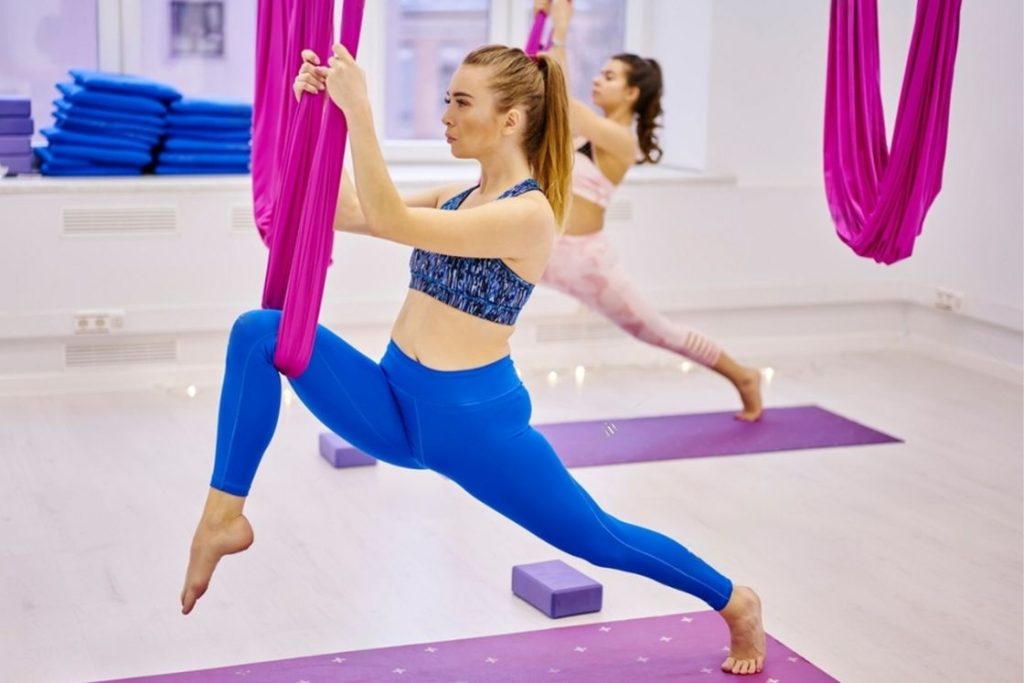
By practising lunges, you are essentially releasing tension and stress in your hips and groin area.
High lunge aerial yoga pose strengthens your calf, thigh, and core muscles. While performing lunges without support is easy in itself, the straps of the hammock/swing will help in providing the extra stretch. You will also be able to keep your spine straight, which is essential for gaining a correct posture.
- Stand in front of the hammock and make sure that the bottom of the hammock/swing is in line with your pubic bone. Separate the straps of the hammock to make a ‘U’ shape.
- Place your right leg on the ‘U’ bend and bend your knee. Now the hammock is supporting your upper leg just above the knee. Your left leg is kept straight with toes pointing forward.
- With your hands on the hips, move forward and inhale deeply. Move as you would when practicing the general lung pose, while keeping your left leg firmly on the ground. Exhale and return to the original position. Repeat this process 5 times.
You can easily transition to the Warrior I pose by stretching your arms above your head and joining the palms.
2. Inverted star pose
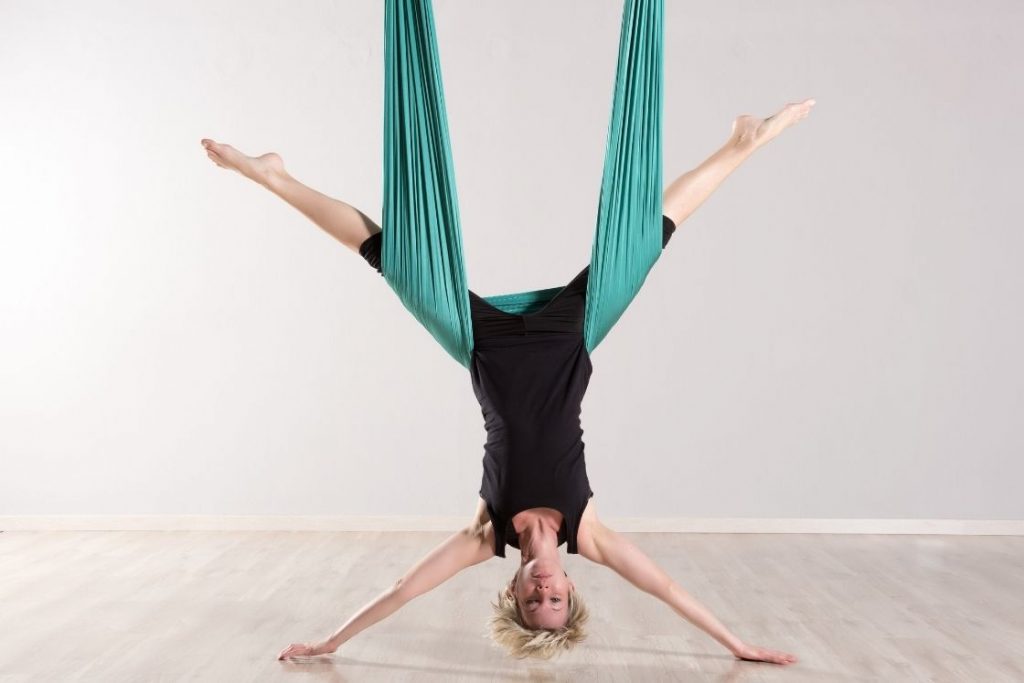
This pose is just what you think it is, an inverted position with your arms and legs spread like a star.
The inverted star pose will help in spine decompression, improve the flow of blood to the brain, and provide relief from anxiety, stress, and poor quality of sleep. Adjust the swing to the correct height so that your head doesn’t hit the floor.
- Stand in the center of the yoga mat and place the ‘U’ bend of the swing/hammock on the buttocks. Slide your arms through the straps of the swing just like you would for backpack straps.
- Slowly lean back on the hammock, engaging your stomach muscles and arms to balance the straps.
- Slightly bend your knees to pull your legs up from the floor and spread your legs apart, to prepare for the star shape.
- Keep leaning backward, with your hands balancing the straps and supporting your hips.
- Once you have been completely inverted, with your head towards the ground and feet spread in the air and you feel comfortable, remove your hands to bring on the floor, spread and palms on the floor.
- Hold this position for 5 slow breathes.
To come back, slowly bring your hands to hold the straps, and in an orderly manner, push yourself up in a seated position on the hammock. Bend your knees and bring your legs down to the ground.
3. Plank pose
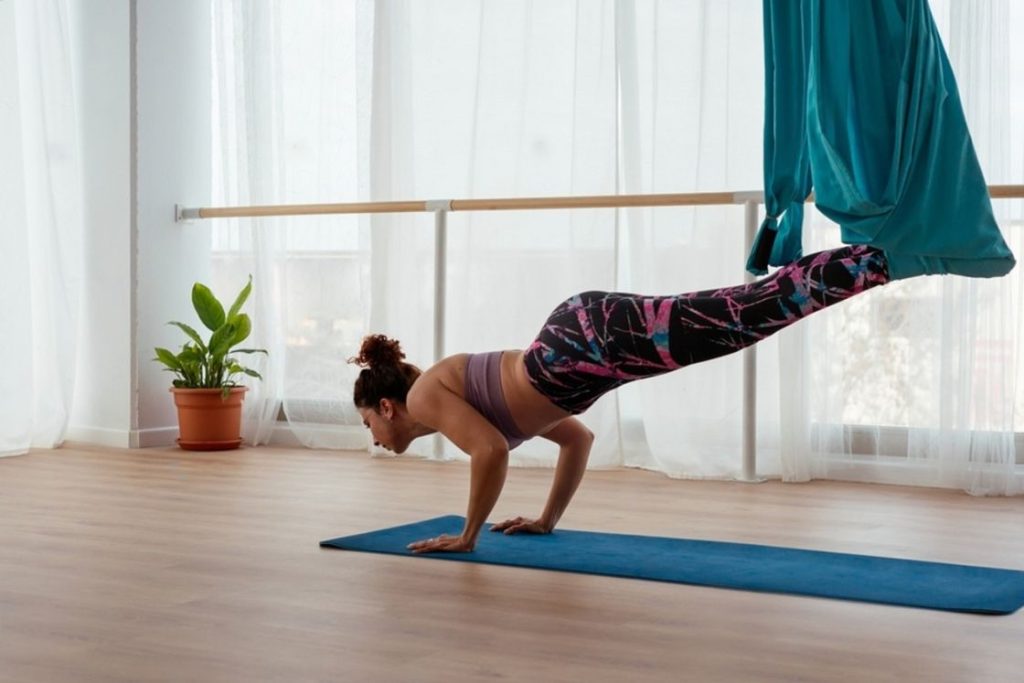
Performing a plank is considered one of the most difficult yoga poses as you have to heavily rely on your arms, shoulder, abdominal and upper body muscles to maintain a plank-like posture.
Using a hammock to balance your legs can alleviate some of that pressure and also help you maintain the pose for a longer duration. It is a great variation for people with lower back pain.
- Start with the push-up position. You can also bend your knees to touch the floor for more comfort.
- Put one foot on the ‘U’ bend of the hammock/swing while keeping your arms straight and engaging your abdominal muscles to find stability.
- Once you are stable enough, pull up the other foot as well to come beside the first foot. Make sure that your legs are in line with the spine. You can take the help of a spotter or instructor to adjust the swing/hammock accordingly.
Even with the support, you will feel your core muscles putting the effort to keep your posture straight.
4. Headstand
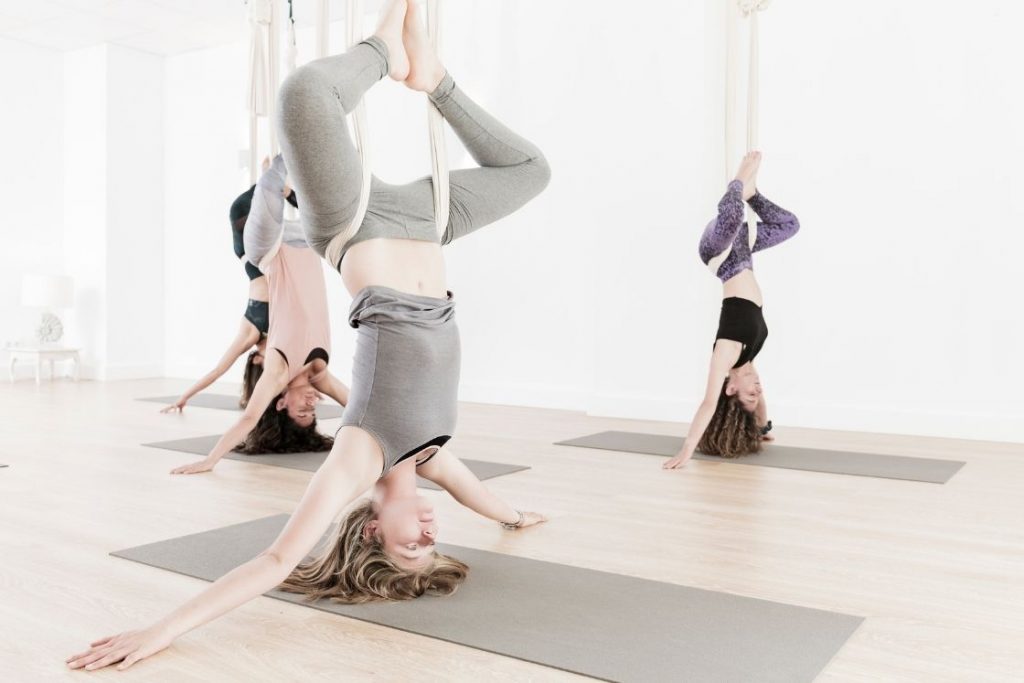
Headstand is yet another difficult pose that is considered to be an advanced yoga pose. When performed on a mat, you can only practice headstand when you have built enough core strength and stability to hold your balance.
Performing headstand in aerial yoga is a classic example of how a prop can support a beginner in doing some of the most difficult poses with ease. In this pose, you are directing the blood flow towards the head, helping in spinal decompression, improving mental clarity, inducing a calm mind, reducing stress and anxiety, etc.
- Perform all the initial steps as you would for an inverted star pose, however, instead of spreading your legs, your legs will remain closed.
- Wrap the straps of the hammock/swing around your ankles for additional support.
- Bring your hands on the floor, palms facing down, and make sure that some of the weight is also being held by the arm muscles.
- Hold this position for 2 to 4 minutes.
Benefits of Aerial Yoga
Aerial yoga may sound and look intimidating but it can be performed by any person, with exception of persons with medical issues. Even if you don’t have a prior yoga practice or are overweight, you can easily start with aerial yoga practice.
1. Balance and strength are enhanced
In addition to improving your balance, aerial yoga helps you to develop muscular strength by forcing you to stay upright in the hammock with the help of your arms and core.
The swings/hammocks support deep stretches and full-body movement which enhances flexibility and strengthening of the muscles.
2. It helps to improve posture
The decompression and stretching of the spine reduce stress in the spine and improve posture as a result of its use. Aerial yoga is great for spinal decompression.
The therapeutic practice of stretching in hanging pose helps in stretching your spinal columns and it gets the room to expand and breathe. In turn, elimination of back and spinal issues, as well as the promotion of excellent health, result from this.
3. It aids in weight loss
The pull-up into a vertical sit-up, inner connection, back bending, swinging to and forth, flips, and aided toe touch, are all great for increasing strength and calorie burn while also increasing flexibility.
In a 2016 survey by the American Council on Exercise, 16 healthy female participants aged 18 to 45 lose participated in a six-week aerial yoga program. It was found that 50-minute of aerial yoga burned 320 calories subsequently reducing the risk of cardiovascular diseases such as heart attack.
4. It helps to improve blood circulation
Aerial yoga facilitates your body’s exploration of its capabilities. It helps to enhance blood circulation since your body is hung, and it also tones your muscles and increases flexibility.
With the myriad of movements in the swing/hammock, the overall circulation of blood and oxygen enhances tremendously. Your breathing is controlled and rhythmic, which improves the oxygen flow.
5. Other benefits
- The support of the hammock/swings means that there is no harmful impact on the tendons, joints, and bones hence you can also perform asanas that you thought were difficult for you on the yoga mat.
- You are using your body to move within a fabric and are floating in the air, which requires stability. Your core muscles are engaged throughout the practice, helping in strengthening them as well.
- In the long-term, all these above benefits improve your confidence, self-esteem, mood, focus, and concentration. You will also feel a sense of wholeness and inner peace.
Conclusion
Performing poses while defying gravity will not only allow you to build a balance but will provide you with the flexibility you have always wanted to achieve. Many poses can be easily modified to suit your level of expertise hence aerial yoga can be easily performed by anyone.
Go to an aerial yoga class with an open mind. Think as if you are back in your childhood and are going to play on the swings, with the variation of performing a workout in a fun manner. Trust yourself, your body, your mind, and of course, your sling to give the body and mental well-being you have been dreaming of!

